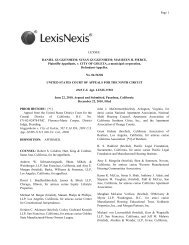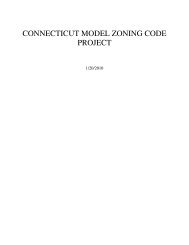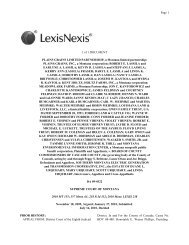Through a Glass Darkly: Measuring Loss Under ... - Land Use Law
Through a Glass Darkly: Measuring Loss Under ... - Land Use Law
Through a Glass Darkly: Measuring Loss Under ... - Land Use Law
You also want an ePaper? Increase the reach of your titles
YUMPU automatically turns print PDFs into web optimized ePapers that Google loves.
MEASURING LOSS UNDER MEASURE 37 597<br />
components as the actual land value, except for those variables/components<br />
caused by, or resulting from, the “enactment or enforcement” of<br />
the specific land use regulation. While such an interpretation is contrary<br />
to the express intentions of the authors, analyzing the use of the CPI as<br />
a multiplier is useful in order to highlight the almost insurmountable<br />
difficulties one faces in establishing an accurate hypothetical value.<br />
The difficultly in using the CPI as a multiplier is that it is necessary<br />
to make the assumption that, had the regulation never been<br />
“enacted or enforced,” the price of the property would have risen in<br />
direct correlation with the CPI. However this assumption is unlikely<br />
to be accurate. If the analysis takes place over an extended period on<br />
an institutional level, 119 there is likely to be a rough correlation<br />
between the rise and fall of property prices and the rise and fall of the<br />
CPI. Yet the CPI is influenced by many different variables, only one<br />
of which is land price, and thus there is a potential divergence between<br />
the inflation rate set by the CPI and the inflation rate for land prices.<br />
This divergence is only exaggerated when analyzed on the individual<br />
level. It is possible that the rise in the CPI could bear absolutely no<br />
correlation to the fluctuation in the value of the affected land, or land<br />
in that particular area. For instance, what happens if the value of the<br />
affected land or the land in the particular area declined as a result of<br />
something entirely unconnected to the land use regulation, such as a<br />
natural disaster, years of bad harvest, or a drop in rental market<br />
While the CPI may be affected by such happenings, it would not<br />
accurately reflect the loss in value that the affected land actually suffered<br />
(i.e., with the regulation), and importantly that the affected land<br />
would have hypothetically suffered in the hypothetical scenario (i.e.,<br />
even if the regulation had never been enacted). The following diagram<br />
illustrates such a phenomenon 120 :<br />
119. That is, in relation to land prices as a whole.<br />
120. The major problem with the Plantinga/Jaeger method is that the differential<br />
between the hypothetical and actual values (and hence the compensation) is affected by<br />
too many variables. In fairness, it should be noted that the “too many variables” problem<br />
is inherent in economic modeling. In the diagram, between the time of enactment<br />
and the time of A, the actual value rises at a faster rate than the hypothetical value; this<br />
presumes that there is an the increase in price of the property caused by the “long term”<br />
effects of the regulation (amenity effects, etc.—there could quite easily have been a<br />
negative “long term effect”). The method is working correctly thus far, because it is<br />
taking into account only the effects that the land use regulation has on the differential.<br />
However, let us presume that at point A, a natural disaster (which is entirely disconnected<br />
to the land use regulation) occurs in the area, rapidly reducing the value of the<br />
affected land. While this would affect the actual value of the land greatly, the hypothetical<br />
value is, to an extent, insulated from the risk because it is augmented by the<br />
CPI, which is a national standard and likely only to be mildly affected by the disaster.<br />
ABA-TUL-07-0701-Sullivan.indd 597<br />
9/18/07 10:43:43 AM







